The Allure of Bedroom Mirrors: A Space Reimagined
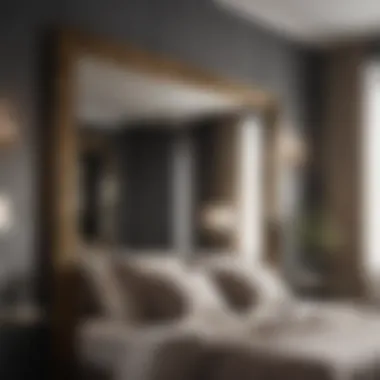
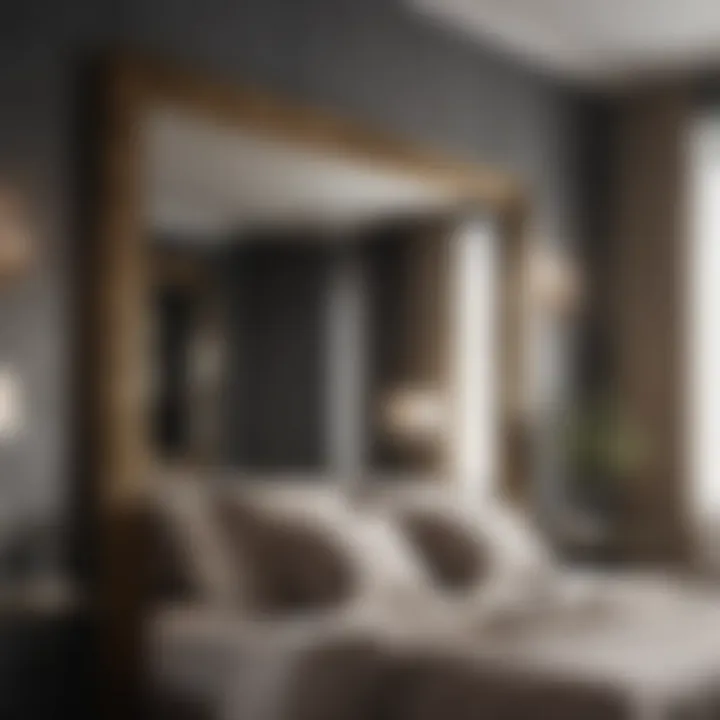
Intro
When one thinks of mirrors, it’s often about checking one’s appearance before dashing out of the house. Yet, in the realm of interior design, especially in the bedroom, mirrors are far more than mere reflective surfaces. They emerge as transformative elements, able to shape the atmosphere, perception, and even emotions within a space.
In this article, we will explore the fascinating world of bedroom mirrors, diving deep into their aesthetic enhancements, the way they play with spatial perception, and their functional purposes. We’ll also delve into the psychological effects mirrors can have on us, reflecting not only our physical forms but the vibes of our personal retreats.
Additionally, we will touch upon trends in mirror styles and the color palettes that can elevate any bedroom decor. For those who seek both beauty and practicality, maintenance tips and design trends will guide you towards making informed choices when you integrate these reflective gems into your sanctuary.
Understanding Mirror Walls in Bedroom Design
In the realm of interior design, mirror walls play a crucial role in redefining and enhancing living spaces, especially bedrooms. They are not mere decorative elements; they carry a multitude of benefits that can transform any ordinary room into an extraordinary retreat. Understanding the dynamics of mirror walls in bedroom design is paramount for homeowners and housewives looking to make impactful changes in their surroundings.
One significant aspect of mirror walls is their ability to create an illusion of space. This is particularly beneficial in smaller bedrooms, where every inch counts. By strategically placing mirrors on walls, one can generate an airy and expansive feel, making the room seem larger than it actually is. This visual trickery doesn't just amplify space; it also enhances the light in the room, fostering a more inviting and cheerful atmosphere.
Moreover, mirrors serve functional purposes too. They are invaluable when it comes to daily routines, offering a perfect spot for dressing and grooming. Having a mirror wall eliminates the need for multiple smaller mirrors, which can clutter the space and make it feel crowded. In essence, these reflective surfaces streamline functionality, adding to the overall convenience of the room.
From an aesthetic viewpoint, mirror walls can be a striking centerpiece that elevates the decor of the bedroom. They can complement various styles, whether modern, vintage, or minimalist, and introduce an element of sophistication and elegance. It’s not just about having a reflective surface; it’s about how that surface interacts with lighting, colors, and overall design.
Historical Context of Mirrors in Interior Design
To truly appreciate the allure of mirror walls in contemporary settings, one must look back at their historical origins. Mirrors have long been symbols of status and beauty, dating back to ancient civilizations. In the homes of the wealthy during the Renaissance, for instance, mirrors were crafted with intricate designs and used to showcase wealth and power. People would adorn their walls with large, elaborately framed mirrors not only to reflect light but to manifest their affluence.
As time progressed, the functionality of mirrors evolved. They began to appear in more modest homes, promoting not just opulence but also practicality. By the 19th century, the incorporation of mirrors in interior design became commonplace, influencing styles like Art Nouveau and Arts and Crafts. Each era brought unique interpretations of mirrors, showcasing their evolution from mere tools of vanity to integral design elements.
Contemporary Trends and Preferences
In today’s fast-paced world, the modern homeowner’s approach to mirror walls is markedly different. With an eye for innovation, designers are experimenting with mirror sizes, shapes, and placements. Instead of standard rectangular mirrors, curvier designs or asymmetrical patterns are gaining traction, giving a more organic and less formal feel to spaces.
Furthermore, trend analysis shows a rising preference for mirrors that are more than just reflective surfaces. Consider smart mirrors equipped with LED lights, integrated speakers, or even touch-sensitive controls. This is where functionality meets tech innovation, seamlessly combining utility with modern aesthetics.
In the end, understanding mirror walls is about grasping their multifaceted roles in bedroom design. They are reflections of history, trends, and personal taste, woven into the very fabric of our living spaces. By recognizing these elements, homeowners can make more informed choices when it comes to curating rooms that reflect who they are while also meeting their practical needs.
"The right mirror can be the difference between feeling cramped or cozily nestled in your space. It's all in the reflective magic."
The interplay of functionality and aesthetic appeal in mirror walls is what makes them indispensable in bedroom design, adding depth, light, and a touch of personal flair.
Aesthetic Transformation Through Mirrors
In the realm of interior design, mirrors hold a unique power. The incorporation of mirror walls in bedroom spaces can significantly alter the aesthetic landscape of the room. This transformation is not merely about visual appeal; it touches upon elements such as light, perception, and emotional resonance. Through strategic placement and thoughtful design, mirrors can enhance both the style and functionality of a bedroom, creating a space that feels more inviting and expansive.
Creating Depth and Space Illusion
One of the most compelling aspects of mirror walls is their ability to create a sense of depth and space in a room. Imagine a compact bedroom that often feels cramped and confined. By integrating a mirror wall, the space can instantly appear larger and more open.
Mirrors reflect not just light, but the very essence of the room itself. When placed opposite windows or light sources, they can bounce illumination throughout the space. This effect can transform a dim corner into a bright nook, enhancing the overall ambiance. Additionally, mirrors reflect views from outside, bringing the essence of nature indoors without the need for costly renovations.
However, it is essential to choose the right type and style of mirrors for this purpose. For instance, floor-to-ceiling mirrors can create an illusion of height, making the room feel more airy and expansive. On the other hand, strategically placed smaller mirrors can be sprinkled around to maximize light reflection, guiding the eyes naturally around the space.
Innovative Design Techniques
Layering with Lighting
Layering with lighting can dramatically enhance the effects of mirrors in bedroom design. By combining various sources of light—ambient, task, and accent lighting—you can create a warm and inviting glow that complements the reflective surfaces.
Key Characteristics of Layering with Lighting:
The idea here is simple yet powerful—the right lighting can bring out the best in mirrors. Dimmer switches, wall sconces, and bedside lamps can work hand in hand with mirror walls. When light hits the mirror, it can amplify its brilliance and richness, making the overall decor look more polished and sophisticated.
A Unique Feature of Layering with Lighting:
This method allows for flexibility. You can adjust the intensity of the lights to create different moods, from an intimate setting for relaxation to a bright atmosphere for more lively activities. One drawback, however, might be the increased energy consumption if the lights are used excessively.


Textural Contrast
Bringing textural contrast into your design can add a layer of character to a space adorned with mirrors. The interplay between reflective surfaces and contrasting textures can set a vibrant tone.
Key Characteristics of Textural Contrast:
For instance, if you have a sleek glass or polished mirror, pairing it with soft fabrics like velvet curtains or a chunky knit throw blanket can create a delightful visual juxtaposition. This adds depth and richness to the room's design, making it more inviting.
Unique Features of Textural Contrast:
Adding varied textures can evoke certain feelings; touching a soft blanket vs. a cold mirror can create sensory diversity. Yet, one has to be cautious. Overdoing it may lead to a cluttered appearance, distracting from the mirror’s intended elegance.
Colors and Patterns
Colors and patterns play a vital role in enhancing the aesthetic appeal of mirrors in bedroom designs. Utilizing the right colors can complement the mirrored surfaces while still maintaining a cohesive theme.
Key Characteristics of Colors and Patterns:
Bold patterns or soft pastel shades around a mirror can amplify its allure, creating focal points that draw the eye. This strategic placement can highlight the reflective surface, turning mere functionality into a centerpiece.
Unique Features of Colors and Patterns:
While incorporating colors, consider the psychological impact they can have on the mood. Bright colors can energize, while cooler tones can promote tranquility. However, one must balance vibrant patterns carefully—too much can overwhelm a space and defeat the purpose of introducing mirrors as design elements.
Functional Aspects of Mirror Walls
When it comes to bedroom design, the functional aspects of mirror walls draw a blueprint for a space that is not only beautiful but also practical. From enhancing the lighting to serving as versatile decor, these mirrored installations redefine how we perceive and utilize our sleeping quarters. The integration of mirror walls offers a plethora of functional benefits that transcend mere aesthetics, ensuring that the choices made in this realm resonate on a daily basis.
Practical Benefits in Daily Use
Enhanced Lighting
One of the standout features of enhanced lighting provided by mirror walls cannot be overstated. Mirrors have an innate ability to amplify both natural and artificial light. Placing mirrors opposite windows harnesses daylight, effectively doubling the sunlight that streams in. This illumination fosters a warm, inviting ambiance in any bedroom, greeting you every morning with brightness. The unique feature of redistributing light creates a significant difference in how the space feels and functions, leading to a more uplifting atmosphere. However, it’s worth noting that careful positioning is essential; if mirrors reflect a cluttered space, it may inadvertently amplify that chaos.
Visual Sequence
The concept of visual sequence is another critical aspect that mirror walls contribute to the bedroom’s design. By creating a reflective pathway, mirrors can guide the eye around the space, making it feel larger and more cohesive. Their placement can lead to a seamless transition from one area to another, providing a smooth visual journey. A key characteristic of this effect is how mirrors can extend the sight lines, thereby enhancing the overall flow of the bedroom. Yet, too many mirrors in one direct line can create visual confusion rather than clarity, so balancing placement is vital to maintain harmony.
Mirrors as Decorative Elements
Beyond mere functionality, mirrors as decorative elements add a layer of sophistication and style to any bedroom. They serve not just a practical purpose but are also pivotal in defining the room's aesthetic. A well-chosen mirror can act as a statement piece that ties different design elements together, highlighting color schemes, patterns, or stylistic interpretations. They are beneficial because they can capture and reflect the unique traits of the decor, adding depth and character. The downside, however, is that if the style does not complement the existing elements or themes, it may stand out in an unflattering manner.
Complementing Bedroom Functions
Dressing and Grooming
The dressing and grooming aspect of mirror walls cannot be ignored. A thoughtfully placed mirror facilitates daily routines—be it for a quick outfit check or a leisurely grooming session. The reflective surfaces provide ample opportunities for self-examination, allowing individuals to put their best foot forward each morning. A key characteristic is accessibility; having a mirror in close proximity to your dressing area saves time and enhances efficiency. However, if a mirror is placed poorly, it can inadvertently create awkward reflections that may distract rather than help.
Spatial Organization
Spatial organization becomes immensely easier with the inclusion of mirror walls. They can delineate areas within the same room, giving that much-needed structure without using physical dividers. This unique feature allows for an uncluttered aesthetic, essential for small spaces, as mirrors can increase perceived space. Enhanced spatial awareness through reflections can enable occupants to navigate their room with greater ease. However, harsh lines or too many walls can diminish the effect, highlighting the need for thoughtful integration.
"The beauty of mirror walls lies not just in their reflections but in their ability to transform how a space is experienced."
Choosing to incorporate mirror walls in a bedroom isn’t merely about functionality; it’s a decision that can impact how the environment feels and serves its inhabitants. With a focus on both benefits and potential drawbacks, homeowners can create spaces that merge practicality with aesthetic delight.
Psychological and Emotional Implications
In the world of interior design, mirrors serve more than just a functional purpose; they also have a profound effect on our psychology and emotions. The presence of mirrors in a bedroom can lay the groundwork for a deeper connection with one’s self and create an ambiance conducive to tranquility. This section explores how mirrors do not merely reflect our physical appearance but also influence our sense of identity and emotional well-being in significant ways.
Reflections of Self-Identity
Mirrors have long been metaphors for self-discovery and reflection—pun intended. When positioned thoughtfully, mirrors can serve as a tool for self-empowerment and reflection, encouraging individuals to confront their self-image. In a space like a bedroom, where personal expression thrives, mirrors can cultivate a stronger understanding of who we are.
Although physical appearance is often the first thing we notice, mirrors invite a more profound contemplation of self-identity. For instance, when someone arranges their mirrored wall, it can signal how they wish to be perceived; they might choose a bold, ornate frame to evoke a sense of luxury or a sleek, frameless design for simplicity and modernity. Each choice is a reflection of personal values, preferences, and aspirations, making the mirror a powerful ally in understanding one's identity.
Creating a Sense of Calm and Clarity
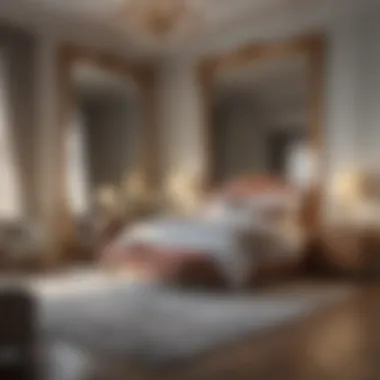
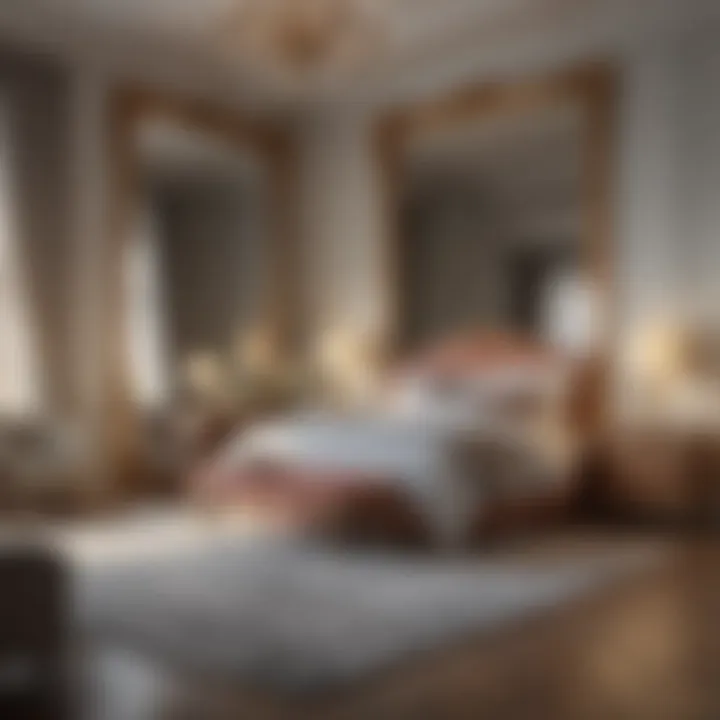
Mirrors can significantly affect our mood and overall atmosphere in a bedroom. By incorporating mirrored surfaces, homeowners can create an environment that feels spacious and serene. This transformation contributes to a more positive emotional landscape, promoting relaxation and peace.
Effects on Mood
The linkage between mood and the environment is something many recognize but may not fully grasp. Mirrors can enhance light, making a room appear larger and more open, which can directly uplift spirits.
- Key Characteristic of Effects on Mood: Mirrors reflect light, creating an illusion of brightness and amplifying the natural light that enters the room.
- Why it's Beneficial: This characteristic is particularly appealing for those looking to mitigate feelings of claustrophobia or gloom, especially in smaller bedrooms.
- Unique Feature: Another notable aspect is how mirrors can evoke a sense of harmony. When you catch a glimpse of yourself in a lovingly curated space, it can substitute negative thoughts with affirming ones, making a positive emotional impact.
- Advantages: This can be vital for fostering a peaceful mindset that allows for restorative sleep.
Mindfulness Practices
Mindfulness is not just a buzz word; it’s a practice that many are now embracing to enhance their quality of life. Integrating mirrors into mindfulness practices can lead to improved emotional clarity. Sitting by a mirror and gently focusing on one’s own reflection can promote self-awareness and acceptance.
- Key Characteristic of Mindfulness Practices: The use of mirrors encourages engagement with oneself, which can aid in breaking patterns of discontent.
- Why it's Beneficial: Practicing mindfulness in front of a mirror can reinforce positive self-talk and acceptance, leading to lower anxiety levels.
- Unique Feature: Mirrors can become platforms for affirmations—individuals can recite positive statements while looking at their reflection, improving self-esteem and emotional fortitude.
- Advantages: This engagement with self allows individuals to confront their inner dialogue, gradually leading to a more harmonious sense of self, ultimately creating that desired calm in their personal oasis.
"The ability to reflect is not just a physical property of mirrors; it's a pathway to understanding ourselves more deeply."
In summary, the psychological and emotional implications of incorporating mirrors into bedroom design are multifaceted. They serve not just as decor but as tools for deeper self-reflection and emotional well-being. The synergy between how a person sees themselves in a mirror and how they feel about their space can create an enriching atmosphere that promotes tranquility, understanding, and positivity.
Considerations for Incorporating Mirror Walls
Incorporating mirror walls into bedroom design is more than just a trend; it’s about transforming the entire space into something more functional and aesthetically pleasing. When implemented thoughtfully, mirrors can redefine how a room feels and functions. Here, we'll explore the key considerations that can guide homeowners and decorators in their decision-making process.
Space and Layout Optimization
Room Size and Shape
When thinking about mirror walls, one of the first things that come to mind is the size and shape of the room. A room's dimensions can greatly affect how mirrors will be used to enhance its overall appeal. For smaller spaces, a well-placed mirror can work wonders, creating an illusion of expanded floor area. The reflective nature of mirrors bounces light around, making rooms feel more open and airy.
However, it’s essential to take into account the shape of the room.
- Key Characteristic: Square or rectangular rooms often benefit more from mirror walls since the reflections can add symmetry or visual interest. Conversely, in unusually shaped rooms, strategic placement can help balance the aesthetics.
- Unique Feature: While mirrors help in making the space feel larger, they can also overwhelm if not done in moderation or with careful design consideration.
Furniture Arrangement
Another critical aspect connected with incorporating mirror walls is the furniture arrangement. The placement of furniture can dramatically affect how a mirror wall operates within a room. Well-placed furnishings can interact beautifully with mirrored surfaces, enhancing the overall ambiance.
- Key Characteristic: Arranging furniture in a way that allows for comfortable movement and interaction is crucial. When mirrors reflect these arrangements, it creates a sense of harmony and can double the visual impact of the decor.
- Unique Feature: Careful placement can help avoid the bottleneck effect, where spaces feel cramped. But too much reflection can also distract from the function of specific zones in the bedroom.
Maintenance and Care
Maintaining mirror walls is another aspect that shouldn’t be overlooked. Cleaning and caring for mirrors is crucial to maintain their lustrous appeal and ensure they contribute positively to the room’s atmosphere.
Cleaning Techniques
Keeping mirrors clean may seem like a minor detail, but there’s an art to it. The techniques used can significantly contribute to the longevity of the mirrors and preserve the aesthetic quality of the bedroom.
- Key Characteristic: Opt for gentle cleaners that will not scratch the surface. Vinegar mixed with water offers an affordable, effective cleaning solution that leaves no streaks.
- Unique Feature: Using a microfiber cloth can result in a sparkling finish, which can elevate the look of your overall decor. Yet, if not done gently, harsh tools or agents might cause scratches.
Avoiding Damage and Wear
Mirrors, while captivating, require careful handling to prevent damage and wear over time. The considerations here can dictate how long a mirror maintains its beauty and functionality in a bedroom.
- Key Characteristic: It's important to avoid direct exposure to high humidity and extreme temperatures, as these can warp frames or tarnish glass edges. Well-maintained mirrors can last for years, adding value to a room.
- Unique Feature: Regularly checking for any pressures or strains from hanging fixtures can help prevent unexpected wear. A proactive approach can spare homeowners from costly replacements.
In summary, thoughtfully incorporating mirror walls into bedroom spaces can lead to a dramatic transformation. By considering factors ranging from room size and layout to maintenance practices, one can create a beautifully reflective sanctuary that is both stylish and functional.
Balancing Style and Practicality
When it comes to incorporating mirrors into bedroom design, striking the right balance between style and practicality is key. This section explores how these elements intersect, offering practical solutions while enhancing the aesthetics of a space. A well-chosen mirror can elevate a room's visual appeal, serving as both a striking focal point and a functional asset. However, it’s not just about aesthetics; one must also consider how the mirror will fit into the lifestyle and daily routines of the inhabitants.
Choosing the Right Mirror Types
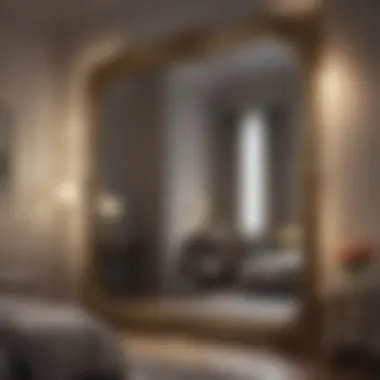
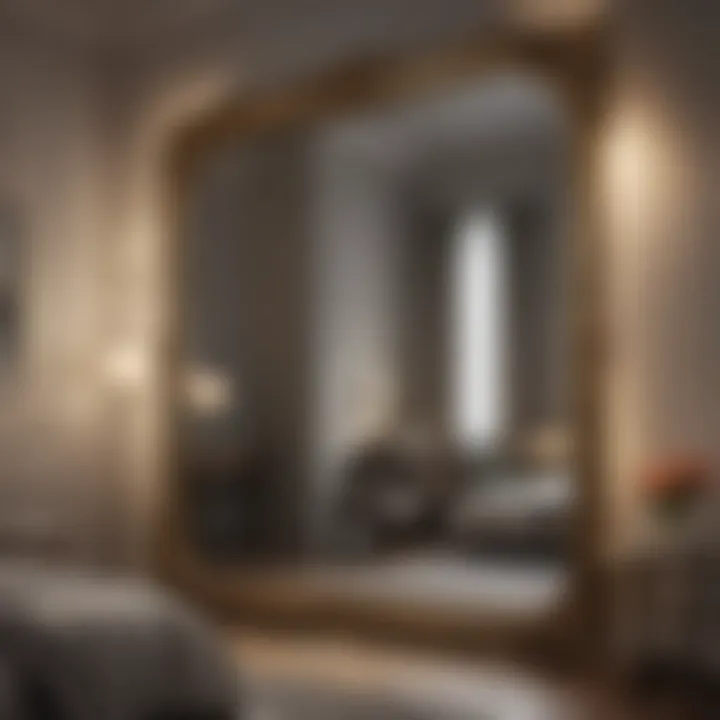
Framed vs. Frameless
The choice between framed and frameless mirrors can significantly impact the overall feel of a bedroom. Framed mirrors are often seen as more traditional, adding a touch of elegance and sophistication. The frame can be a statement piece, complementing or contrasting with other decorative elements in the room. The key characteristic of framed mirrors is their ability to introduce texture and detail; think ornate gilded frames harking back to Victorian designs, or sleek metallic frames that fit well in a contemporary setting.
On the other hand, frameless mirrors have gained popularity for their minimalist allure. They create an illusion of space, making them particularly beneficial in smaller rooms by providing a sense of openness. A unique feature of frameless mirrors is how they reflect the surroundings without the added bulk of a frame. This can be advantageous when aiming for a clean, uncluttered look.
Both options have their merits. Framed mirrors can be more expressive, while frameless mirrors can keep a room feeling airy. The choice largely boils down to your preferred design philosophy and what you want to express in your space.
Size and Shape Considerations
The size and shape of mirrors cannot be underestimated in their contribution to a well-designed room. Larger mirrors can act as dramatic focal points, especially when used strategically across from windows to maximize natural light. A tall, full-length mirror, for example, not only serves a functional purpose for dressing but also expands the feeling of height and space in a shorter room.
Shapes also play a crucial role. Round mirrors, for instance, can soften the angularity of a bedroom, providing a contrast that feels relaxing. Rectangular mirrors tend to offer a more structured look, which can match well with contemporary furniture. The strength of size and shape considerations lies in their ability to personalize spaces. Choosing wisely can enhance the existing layout and work in harmony with other furnishings, making the area feel more cohesive.
Integrating with Existing Decor
Cohesion with Color Schemes
To fully embrace the allure of mirrors, integrating them with existing decor is essential. Color schemes create the foundation of a room's personality, and mirrors can either harmonize or disrupt that flow. Choosing mirrors that reflect the dominant colors in your decor can unify the space. For example, a mirror framed in the colors of your bedding or artwork can tie the whole room together.
The beauty of ensuring cohesion with color schemes means creating a visual story that feels seamless. Mirrors not only enhance the colors around them but also amplify light, which can alter the perception of the room's tones entirely. Consider how different hues reflect differently with light; a bright, colorful room might benefit from a simple, clear mirror that doesn’t compete for attention.
Harmonizing Textures
Textures add depth to a room, and mirrors can play a vital role in harmonizing these elements. The texture of a mirror frame, whether it’s smooth glass or a rustic wooden border, can either complement or contrast with other materials in the room, such as plush bedding or polished furniture. A reflective surface can bounce textures off the walls, enhancing the overall feel of the space.
Choosing mirrors that share or contrast textures can create a dimension that intrigues the eye. For instance, a sleek, glass-framed mirror could draw attention to velvet curtains or a wooden dresser. The unique advantage here is that it enriches the visual experience without overwhelming the space, allowing a reflection of a cohesive yet dynamic character.
"The right mirror isn't just an accessory; it's a pivotal piece that can truly transform how we perceive a bedroom's layout and feel."
When thoughtfully selected and placed, mirrors can elevate a bedroom from mundane to magnificent, enhancing both the style and functionality of the space. Keeping these considerations in mind will guide you on your journey to creating a balanced and harmonious bedroom sanctuary.
Exploring Trends in Mirror Wall Design
In recent years, mirror walls have emerged as a focal point in bedroom design, blending aesthetic appeal with functionality. These design elements not only enhance the visual dimensions of a space but also embody personal style, making them essential for modern interiors. Understanding current trends in mirror wall design helps homeowners make informed decisions that can dramatically affect ambiance and utility in their personal sanctuaries. The incorporation of mirrors brings fresh perspectives while also addressing practical needs such as lighting and space perception.
Popular Styles and Motifs
Minimalist Approaches
One standout in today’s design landscape is the minimalist approach to mirror walls. This style favors simplicity and clean lines, stripping away unnecessary embellishment. The key characteristic of this approach is its understated elegance, which allows a space to breathe. A minimalist mirror can transform a crowded room into a serene environment, contributing to the overall feeling of calmness.
With an emphasis on open spaces, minimalist designs often feature large, unobtrusive mirrors that reflect natural light, enhancing brightness without cluttering the aesthetic. A unique feature of this style is its ability to create a continuous visual flow, making rooms appear larger and more inviting. However, some may find that the lack of ornate framing can feel too stark or cold, especially in more traditional homes.
Vintage Inspirations
Another popular motif involves vintage inspirations, where mirrors possess ornate frames and elaborate designs that echo the charm of past eras. The key characteristic of this style is its rich details and craftsmanship, often drawing from different historical periods. These vintage mirrors become statement pieces, enriching the room with a touch of nostalgia.
A unique feature of these designs lies in their ability to add character and warmth to a space. However, one downside is that vintage mirrors can sometimes overwhelm simpler furnishings, making it essential for homeowners to strike a balance. Choosing a few vintage elements can beautifully complement a modern design, but it may require careful curation to avoid a hodgepodge look.
Future Directions and Innovations
Smart Mirrors
Looking ahead, smart mirrors represent a significant leap in design innovation. These mirrors not only serve the basic function of reflection but also integrate technology to enhance daily routines. A defining feature of smart mirrors is their ability to display information, such as news updates or weather forecasts, right before your eyes.
For the modern homeowner, this makes them a highly beneficial choice, merging practicality with luxury. However, the reliance on technology also brings considerations of maintenance and the potential for malfunction, which could detract from their charm if not addressed properly.
Artistic Applications
Artistic applications provide another exciting avenue for mirror wall design. Here, mirrors become canvases for creativity—shapes, colors, and designs are used to reflect personal taste and style. A key characteristic of this trend is its playful nature, allowing homeowners to express themselves through the arrangement and style of mirrors.
One unique aspect is the combination of various materials and forms, which can contribute significantly to a room’s aesthetics. However, this approach can easily tip into chaos if not balanced appropriately. For the discerning homeowner, integrating artistic elements can provide a striking focal point, but one must ensure this artistry complements rather than disrupts the overall design scheme.
Ultimately, navigating through these trends allows for a deeper understanding of how mirrors can reshape not just the physical space of a bedroom but also the emotional experience within it. Balancing style and function becomes essential, presenting an opportunity for personalized spaces that resonate with individual tastes.















